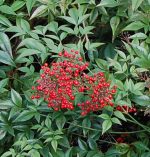
Native to Japan, China, and India, this semi-evergreen to evergreen shrub was introduced into the US in 1804 as an ornamental for its attractive foliage and fruit but has escaped cultivation and become invasive in disturbed areas of the Southeastern states from Virginia to Texas because of its ability to grow quickly and reproduce by suckers, fragments, rhizomes, and seed that are spread by birds. Plants grow well in sun or shade and moderately moist fertile soil. Heavenly bamboo is not a true bamboo but its canes and leaves are similar to those of bamboo leading to its common name
Description: Heavenly bamboo grows 3-8’ tall and has bi- to tri- pinnately compound leaves that are 12-24” long and turn reddish green in winter where the climate is mild. The white summer flowers appear in loose terminal panicles 8-15 ” long and are followed by bright red berries that persist into winter and are attractive to birds. Cultivars are available that vary most significantly in size and fall coloration, and attempts are being made to produce ones that are sterile.
Control: Young plants can be removed manually but care must be taken to remove every piece of the root because even a small piece will re-sprout. To reduce the spread of the plant, cut off the flowers before they set seed but realize that the plant may continue to spread by underground stems. In severe cases good control can be achieved with herbicides such as glyphosate and triclopyr applied to cut stems.